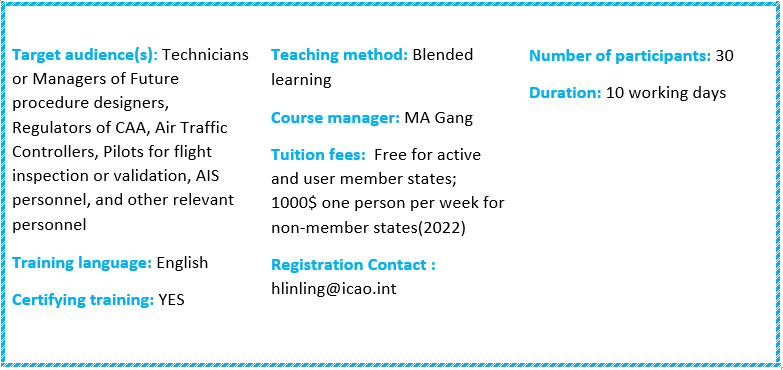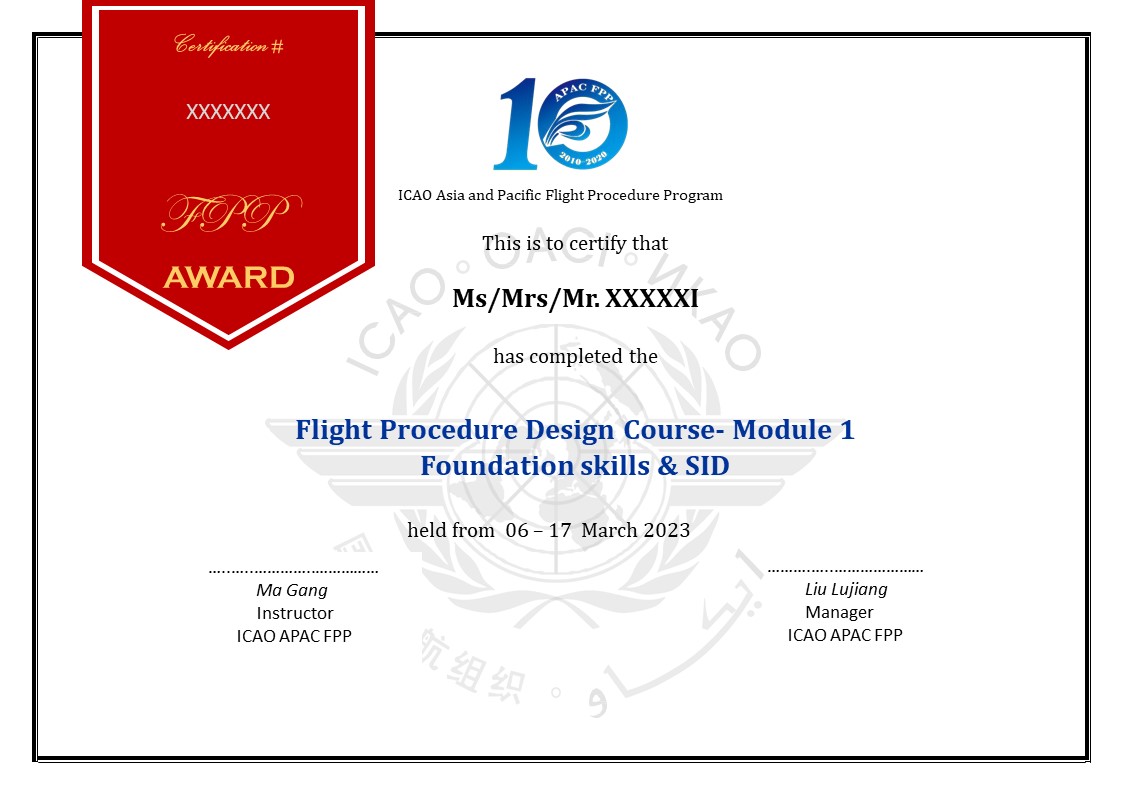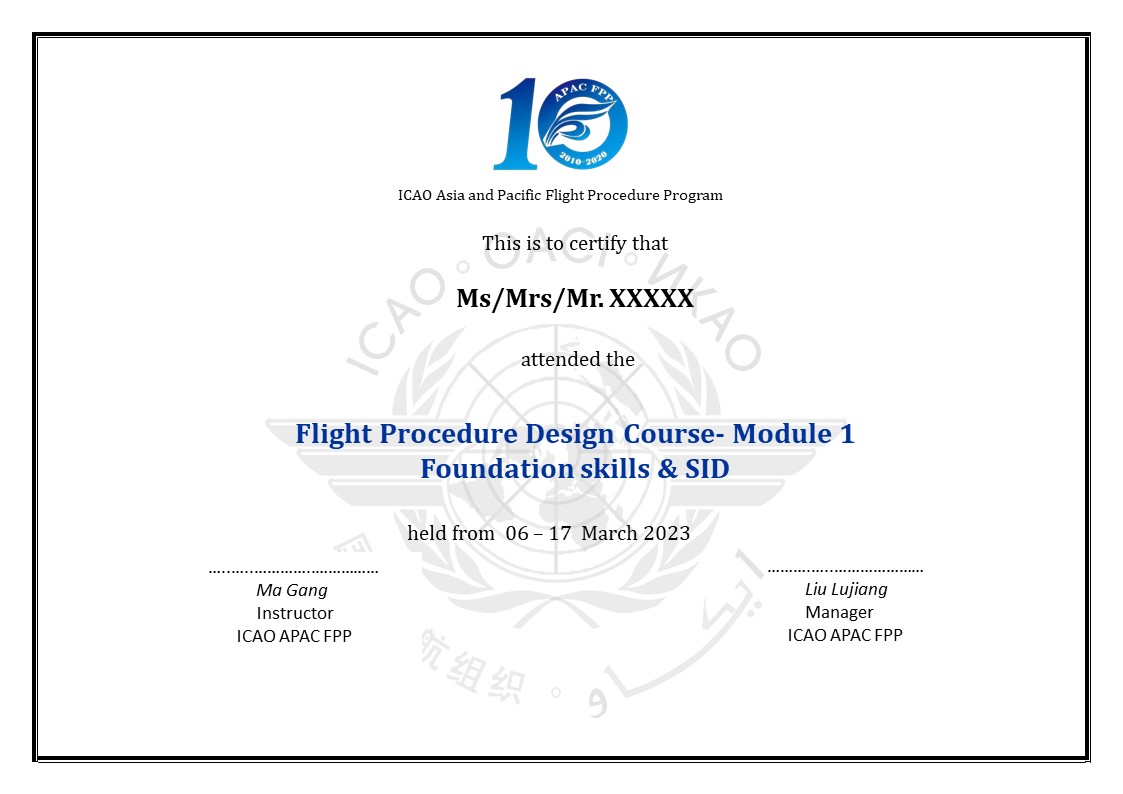
Overview
This course details criteria for the design of NPA procedures and arrival procedures (STARs) for both conventional and PBN navigation.
Objectives
At the end of this training, the participant, as future procedure designer tutored by a senior procedure designer is able to:
- Design or Cross check conventional NPA procedures (ex. VOR approach)
- Design or Cross check PBN NPA procedures (ex. RNP APCH LNAV)
- Design or Cross check conventional and PBN arrival procedures (STARs)
Participants concerned
Future procedure designers, Regulators of CAA, Air Traffic Controllers, Pilots for flight inspection or validation, AIS personnel, and other relevant personnel
Prerequisites
Attendance of APAC FPP Instrument Procedure Design Course: "Flight Procedure Design online Course - Module 1 "or equivalent course is required.
Attendees should feel comfortable to communicate in English.
Tuition fees
- Free for active and User Member States
- 1000$ one person per week for Non-Member States.
Content
At APAC FPP, according to ICAO doc 9906 volume 2, the initial training of IFR procedures designer consists of three main modules. Each module is independent but completing each other, trainees can choose module on demand. This module is considered the second step in a comprehensive training program to design IFR procedure.
The training is organized around courses, exercises and assessments to apply all the regulatory criteria addressing PBN and conventional NPA procedures. The pillars of this training include a case study from ICAO 9368 and a real published procedure.
Focus
The course deals with:
- Two-dimensional (2D) instrument approach operation concept
- Limitation elements of segments
- Coding for PBN procedures
- Publication, procedure design documentation
- PBN and Conventional STARs
- VOR approach with "DME required" procedure
- Demanding criteria applicable in complex environment (offset final approach track alignment criteria, increase of OCA, Missed approach as soon as possible ...)
- RNP APCH procedure (LNAV)
Theoretical courses
2 weeks' courses are in remote classes.
Presentation and explanation of the rules and principles described in Doc 8168-OPS/611.
Exercises
Elementary use of the regulation concepts in a simplified environment, conducted to enforce the theoretical input.
Exercises are daily scheduled.
The exercises about criteria are in remote classes.
Course rundown
| Topic | Module | Further Description |
| Arrival Segment | 2 | Parameters and limitations for this segment, protection areas and Obstacles clearance. |
Initial Approach Segment
| 2
| Parameters and limitations for this segment, Straight, DME Arcs, PBN (RNP APCH) and Reversal Procedures, protection areas and Obstacles clearance. |
| Intermediate Segment | 2 | Parameters and limitations for this segment, PBN (RNP APCH procedure), protection areas and Obstacles clearance. |
| Final Approach Segment | 2 | Parameters and limitations for this segment, PBN (RNP APCH procedure), protection areas and Obstacles clearance. Calculation and publishing of Minima box. |
| Missed Approach Segment | 2 | Calculation of Start of Climb. Obstacle assessment in 3 phases of missed approaches. Turn at a point, turn at an altitude. RNP APCH and conventional procedures. |
| Circling | 2 | Constructions and obstacle assessment for circling area. |
| Minimum Sector Altitudes | 2 | Sectors, Obstacle assessment and publication. |
| Charting/AIP | 2 | Charting requirements, published information for NPA procedures. |
| Holding | 2 | Application of Holding over a NAVID and PBN holding area. |
| ARINC 424 Path/Terminators | 2 | ARNINC 424 coding issues for PBN 2D operations. |
| T/Y Bar Layout Concept | 2 | T-Y bar concept of PBN procedure |
| Terminal Arrival Altitude | 2 | Omnidirectional arrival. Contrast with MSA |
Project
Design of NPA procedures in a geographic and aeronautic realistic environment. The design is carried out step by step under the guidance of instructors. The project includes also the design of chart and appropriate documentation.
Assessment
Several progress tests are carried out to identify the trainee's ability to apply procedure design criteria. Correction of the project is part of the assessment.
At the end of the course, an individual assessment report is provided to each participant.
Certificate issuance
If participants who do not complete the daily practice (homework) during the two weeks of training will automatically lose the chance to attend the final tests.
The final tests can only be taken twice. The pass mark is 60. APAC FPP offers any students with a fail grade to re-take the test. If a participant scores below 80 on both tests, the overall grade of the course will be a fail. If participants who can only take the test once for their personal reasons will automatically lose a chance, we will not provide an opportunity for individual make-up test.
Those who successfully complete and pass the test will be awarded the qualification certificate as below.

APAC FPP can only issue the attending training certificate without the certificate number to those who fail the tests twice.

Assistance
Contact with referent instructor (s) is provided throughout the course.
Delivered course material
Courseware will be uploaded to APAC FPP website.
